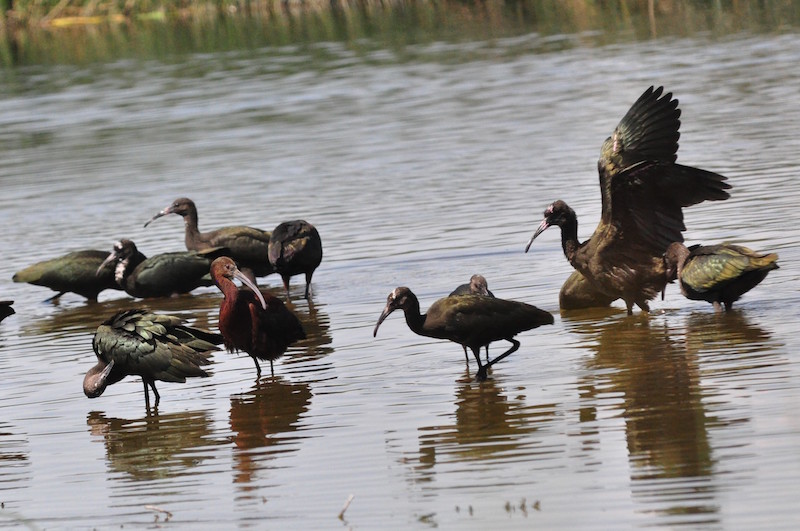Schiess: White-faced ibis – bad table manners
Published at
Sitting in a blind, hidden in the 90 degree temperature heat at Market Lake does not seem like fun – or anything a sane person would do – but I’m probably not very sane and it was fun. I was positioned just 12 feet away from a White-faced ibis nursery.
Twenty to thirty young ibis had gathered on a muddy shore at Market Lake to be fed by the adults of the rookery. The parents would fly to a nearby flooded field to feed on worms and grubs only to fly back to serve lunch to the hungry young.
The most aggressive babes would chase the adult around until they could entice the adult to open its mouth. Down the hatch the long bill would go: full length, sucking the half-digested puree, then leaving a slimy mess as the bill was extracted.
It was a noisy sight with squawking youth, coughing and croaking adults and the beating of wings as both young and old began flying in and out to the feeding fields. A few other species of birds like Snowy egrets joined the group, but not the feeding.
Known as a “congregation” while feeding, White-faced ibis are not black and their white-lined face is sometimes difficult to see after breeding season has passed. A study of adult birds while feeding will reveal that most have a rich brown feathering highlighted by metallic bronze, purple, yellow, green, and even pink over most of the body.
But then there is their beak.
Long and curved but sensitive and pliable; the bill makes the bird look rather homely. Even Pinocchio’s nose was short by comparison.
Designed for specialized feeding, this long bill probes the shallow water and mud searching for precious morsels of food. Earthworms, leeches, insect larva and snails hiding up to six inches under the surface have no chance. With piston-like head bobbing as they walk across a marsh, the ibis’s bill feels for its prey. Once detected, the end of the bill snaps shut, bringing the catch to the surface, and the ibis flips it in the air to swallow it whole.
Many times ibis will have other birds feeding with them. Herons, gulls and egrets feed near them in the Upper Snake River Valley area. The constant probing by the ibis often scares fish, snakes and frogs for the larger feeding compatriots to enjoy. Gulls feeding with them prove a negative, though. In the Market Lake area where the gulls nest and feed near the ibis, the gulls will often steal the food before the ibis can get it down the hatch.
White-faced ibis is named for a small ring of white feathers around their naked cheeks during breeding season. By the end of breeding season these feathers have been lost and their white face becomes more of a red or black one.
Ibis are colony nesters and feeders. As they fly from feeding areas to and from their nesting and roosting areas, they form long formations called “wedgies.” West of Rexburg these formations can be seen every morning and evening as they move to flooded fields from their roosting areas in the Snake River bottoms and nearby marshlands like Market Lake and Camas National Wildlife Refuge.
These awkward-appearing birds are very nomadic; always looking for better feeding areas. With the hot dry summer this year, the flocks have been sparse with only a fraction of the birds that we have seen in other years. Now that most of the young can fly well and with hay fields being flooded, several large flocks have shown up in the last week.
As you drive around, look for the feeding, black mass of wading birds. Stop, pull off to the side of the road and enjoy watching the activities of these interesting birds, for most will be gone by the end of August.
Living the Wild Life is brought to you by The Healing Sanctuary.






